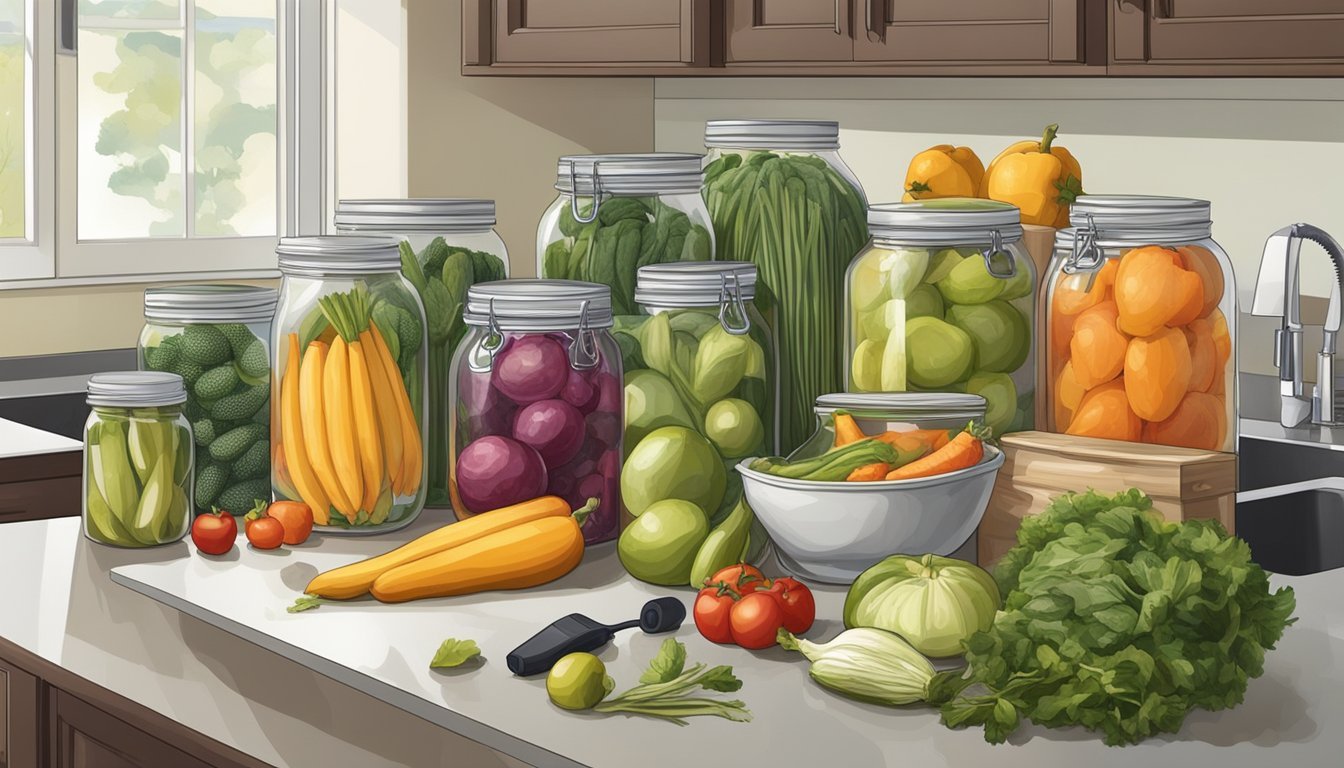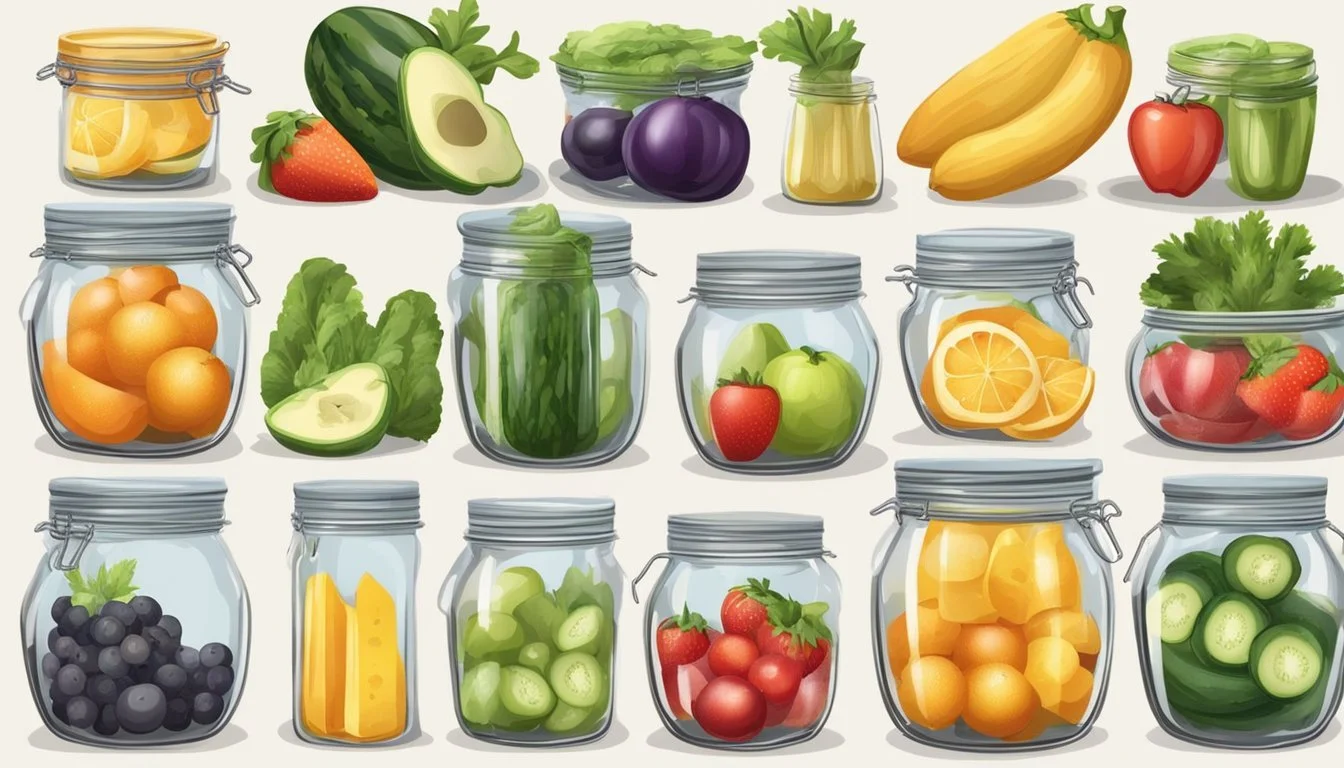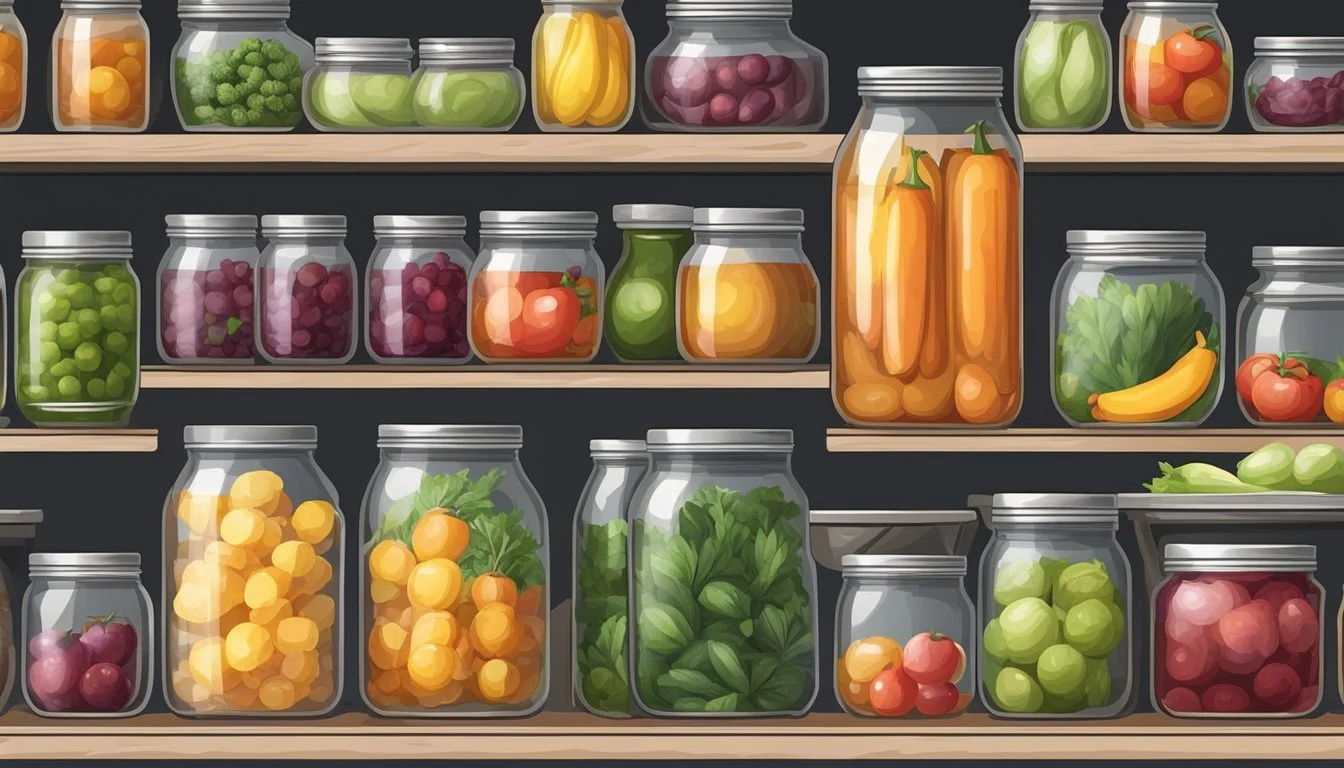Preserving Food at Home
Essential Techniques for Longevity
Food Preservationis a practice that dates back to ancient times, serving as a way to extend the shelf life of produce and other food items well beyond their natural expiration dates. Today, it remains an essential and practical skill that allows individuals to manage food supplies, reduce waste, and enjoy seasonal produce throughout the year. Methods of preservation range from simple techniques such as cool storage and freezing to more involved processes like canning and fermenting.
The modern kitchen is well-equipped for various food preservation techniques. Cooling and freezing are among the most accessible methods, requiring minimum equipment while maximizing the retention of food's nutritional value and flavor. For those looking to explore beyond refrigeration, canning preserves fruits, vegetables, and even meats in airtight containers that can be stored at room temperature once properly processed.
Moreover, there are resources such as the National Center for Home Food Preservation that offer guidance on the latest research-based recommendations. They provide valuable insights into the science behind preservation methods, ensuring safety and efficiency for home practices. Proper preservation can transform perishable items into long-lasting staples, diversifying culinary options and curbing the frequency of required grocery trips.
Understanding Food Preservation Methods
Preserving food at home involves a variety of techniques to extend the shelf life of food products, ensuring both their safety and nutrition are maintained over time.
Basics of Food Preservation
Food preservation is the process of treating and handling food in such a way as to stop or greatly slow down food spoilage while maintaining nutritional value, texture, and flavor. This is achieved by various methods of food preservation, including:
Freezing: Slows down the activity of bacteria, yeasts, and molds. Foods must be properly packaged to prevent freezer burn and maintain quality.
Canning: Involves packing food into airtight containers and heating to destroy microorganisms. The high temperatures needed vary based on the acidity of the food.
Drying: Removes moisture from food, which inhibits the growth of bacteria, yeasts, and mold through dehydration.
Pickling: Food is immersed in an acid solution, usually vinegar, which is hostile to bacteria.
Fermenting: Encourages the growth of good bacteria which produce acids that naturally prevent food spoilage.
Benefits of Preserving Food at Home
Preserving food at home offers several advantages:
Cost-Effective: Bulk purchases or a bumper garden crop can be preserved for later use, saving money.
Quality Control: One controls the ingredients and avoids additives often found in commercially preserved foods.
Variety: Food preservation at home adds diversity to meals by retaining seasonal flavors for enjoyment year-round.
Food Safety Considerations
When preserving food at home, safety is a top priority to avoid foodborne illnesses. It's critical to:
Understand and follow proper canning temperatures to prevent botulism.
Use sterile equipment to avoid contamination.
Know that freezing does not kill bacteria—it merely inhibits growth, so safe food handling before freezing is essential.
Preparation and Pre-Treatment
Proper preparation and pre-treatment are crucial steps in food preservation, ensuring the safety and quality of the preserved items. These processes are designed to stabilize foods like fruits, vegetables, and meats, and to inactivate enzymes that could cause spoilage and decomposition.
Selecting Suitable Foods for Preservation
When preserving, one must choose high-quality, fresh foods. Fruits and vegetables should be ripe, but not overripe, as they preserve best when at peak quality. For meats, select fresh cuts with minimal bruising or signs of spoilage. With berries, look for firmness and absence of mold, as these factors contribute to a better-preserved end-product.
Fruit: Pick without blemishes and at the right stage of ripeness.
Vegetables: Ensure they are tender and have a vibrant color.
Meats: Choose cuts that are fresh and have been handled properly.
Berries: Opt for berries that are firm and mold-free.
Cleaning and Sorting
All food items must be thoroughly cleaned and sorted before preservation. Cleaning washes away surface dirt and reduces the presence of microorganisms. Sorting involves removing damaged or diseased parts which may affect the quality and safety of the preserved product.
Clean:
Rinse under cool running water.
Use a brush for rough-skinned items like root vegetables.
Sort:
Discard items with signs of rot or extensive bruising.
Trim away inedible or damaged parts.
Blanching Techniques
Blanching is recommended for many vegetables and some fruits prior to freezing, as it halts the action of enzymes that can cause spoilage. Blanching methods vary, but typically involve exposing the food items to boiling water or steam for a brief period followed by quick cooling. This process enhances color retention, reduces bacteria, and preserves nutritional value.
Boiling water blanching (for most vegetables):
Boil a pot of water.
Immerse food items for a specific time.
Transfer to an ice-water bath to stop the cooking process.
Steam blanching (for delicate items):
Use a basket in a covered pot with an inch of boiling water.
Steam for the recommended time.
Cool immediately in ice water.
Canning
Canning is a preservation technique that extends the shelf life of food by storing it in airtight containers. This method is ideal for various foods including jams, pickles, and salsa.
Introduction to Canning
Canning involves sealing cooked or raw food in jars and then heating them to kill any microorganisms. The heating also deactivates enzymes that can cause food to spoil. As the jars cool, a vacuum seal forms, effectively preventing the growth of bacteria, yeasts, and molds.
Water Bath Canning
Water bath canning is suitable for high-acid foods like fruits, some tomatoes, jams, jellies, and pickles. The process requires submerging sealed jars in boiling water for a certain period, specified by a trusted recipe or a source.
Essential Supplies:
Canning jars with two-part lids
Large pot with a lid
Jar lifter
Rack to prevent jar breakage
Pressure Canning
For low-acid foods like most vegetables, meats, and poultry, pressure canning is the method of choice. It reaches higher temperatures than water bath canning, which is necessary to eliminate the risk of botulism. Equipment required includes a pressure canner, which may be more expensive than supplies needed for water bath canning.
Key Steps:
Prepare food and canning jars.
Fill the jars and seal them with the lids.
Load sealed jars into the pressure canner.
Follow the canner's instructions for the correct pressure and processing time.
Canning Safety and Botulism Prevention
Canning must be done carefully to avoid contamination and potential foodborne illnesses like botulism. Using proper canning techniques and always ensuring equipment is clean and in good condition are imperative. Additionally, one should always use up-to-date and tested recipes from reliable sources for both methods to ensure safety.
Safety Tips:
Always use a canning recipe tested and recommended by experts.
Never deviate from the recommended processing times and pressures.
Inspect your canned goods before storage and consumption for any signs of spoilage.
Drying and Dehydrating
Drying and dehydrating are time-honored techniques for preserving food through moisture removal, which impedes the growth of bacteria, yeast, and mold. These food preservation methods extend the life of high and low-acid foods including fruits, vegetables, meats, herbs, and spices.
Fundamentals of Drying Food
Drying food is about the strategic removal of water content. This is achieved by applying warmth and air circulation in an environment with low humidity. These conditions must be controlled to prevent the growth of microorganisms and the degradation of food quality. To dry herbs and spices specifically, the process requires careful attention to temperature, as too much heat can lead to loss of flavor and essential oils.
Using a Food Dehydrator
A food dehydrator is a device specifically designed to dry foods efficiently. This food preservation method evenly circulates warm, dry air across food items placed on trays. Here's a brief guide on using a dehydrator:
Preparation: Wash and slice food uniformly.
Temperature: Set according to food type (herbs may require lower temperatures).
Placement: Arrange slices in a single layer, ensuring they do not overlap.
Timing: Check periodically, as dehydration times may vary between food items.
Food dehydrators are ideal for making items like dehydrated fruits or jerky, providing a consistent drying environment regardless of weather conditions.
Sun Drying and Oven Drying
Sun drying is an ancient practice where food is dried outdoors under direct sunlight. It is most suitable in regions with high temperatures and low humidity. When drying food via this method, it is crucial to cover the food to protect it from insects and dust. The process can take several days and requires adequate ventilation to prevent condensation.
Alternatively, oven drying serves as a more accessible method for many, especially in regions unsuitable for sun drying. To oven dry:
Temperature: Keep low, around 140°F to 160°F (60°C to 70°C).
Air Circulation: Leave the oven door slightly open to allow moisture to escape.
Duration: Times vary greatly depending on the slice thickness and water content of the food.
While oven drying is more energy-intensive than using a dehydrator or sun, it can be useful for occasional drying tasks when a dehydrator is not available.
Freezing
Freezing is a reliable method to preserve a wide range of foods including fruits, vegetables, and meats. Frozen food retains nutritional value, flavor, and texture.
Best Practices for Freezing
When freezing food, one should ensure that it is cooled quickly and adequately before storage to maintain safety and quality. Foods should be stored in freezer-safe containers or bags, labeled with the date, and should be filled to allow minimal air space. Vegetables and fruits may benefit from a quick blanching before freezing to preserve color and nutritional content.
Preventing Freezer Burn
Freezer burn can significantly affect the texture and flavor of frozen foods. To prevent this:
Remove as much air as possible from freezer bags.
Wrap foods tightly in foil, plastic wrap, or freezer paper.
Use containers that are moisture-vapor resistant.
Keep the freezer temperature consistent and check it regularly.
Thawing and Using Frozen Foods
Thawing should be done safely to minimize the risk of bacterial growth. The best methods include:
Refrigerator thawing: safest method, although it requires planning ahead.
Cold water thawing: submerging food in cold water, changing the water every 30 minutes.
Microwave thawing: quickest method, ideal for small amounts of frozen foods.
Once thawed, food should not be refrozen raw. Cooked foods that have been thawed may be frozen again if they have been handled properly.
Fermenting and Pickling to Preserve Food
At home, fermenting and pickling are popular methods of food preservation that not only extend the life of foods but also enhance flavors and nutritional value.
The Process of Fermentation
Fermentation involves the natural process where microorganisms like bacteria convert carbohydrates—such as starch and sugar—into alcohol or acids. This acts as a natural preservative and can develop complex flavors and textures in food. Making sauerkraut typifies this process, where lactobacillus bacteria induce the fermentation of cabbage, producing lactic acid and creating a tangy, probiotic-rich food.
Key steps in the fermentation process include:
Choosing fresh, uncontaminated produce.
Preparing and cutting produce to uniform size for consistent fermentation.
Creating a brine or using a starter culture as needed.
Storing the fermentation vessel in proper conditions, away from direct sunlight, at a stable temperature to encourage bacterial activity.
Creating Pickled Foods
Pickling, while similar to fermenting, often involves submerging foods in an acidic solution—typically vinegar—and can include additional components like salt, sugar, and various spices to achieve desired flavors. Cucumbers transformed into pickles through vinegar-based brines exemplify this approach.
Ingredients used in pickling:
Acid: Usually vinegar, which provides the tart flavor and preservation.
Salt: Pickling or canning salt without additives is recommended to avoid cloudiness.
Sugar and spices (optional): To add a range of flavors.
Water: Sometimes used to dilute the vinegar, adjusting the sharpness of the pickling solution.
Pickling steps:
Sanitize jars and tools.
Prepare the brine by boiling vinegar, water, salt, and any additional spices.
Submerge the food in the brine and ensure there are no air pockets.
Seal the containers and store them in a cool, dark place.
Safety is of paramount importance when fermenting foods at home. The right balance of salt, temperature, and hygiene inhibits the growth of harmful bacteria while promoting the desired fermentation process.
Safety measures include:
Using only clean, food-grade equipment and utensils.
Employing good food safety practices, like thoroughly washing hands and produce.
Making sure the food is kept submerged in brine, minimizing contact with air to prevent mold or spoilage.
Maintaining and monitoring the environment where fermented foods (What wine goes well with fermented foods?) are stored is crucial for successful and safe preservation. Conditions such as temperature, which should generally be kept stable and within a certain range, can significantly influence the quality and safety of the final product.
Smoke Curing and Meat Preservation
Smoke curing is a time-tested method that involves exposing meat to wood smoke. One can create a simple smoker at home using a variety of materials and fuel sources such as hickory, maple, or applewood chips. Commonly preserved meats using this method include bacon, sausages, and jerky.
Freeze Drying at Home
Freeze drying is a preservation method where food is frozen and then the water is removed through sublimation, resulting in a dry product with a much longer shelf life. Modern home freeze dryers, such as those from Harvest Right, make this technology accessible to domestic users. Foods ranging from fruits and vegetables to full meals can be preserved using this method.
Immersion in Alcohol and Other Liquids
Immersion in alcohol, such as vodka or brandy, can preserve fruits and some vegetables. The high alcohol content halts microbial growth and thus food spoilage. It is a simple technique where the food items are fully submerged in the alcohol, sealed, and stored. Beyond alcohol, other liquids such as oils and vinegar are also utilized to preserve the flavor and quality of ingredients.
Storing Preserved Foods
Storing preserved food correctly is crucial for maintaining food quality and safety. The right storage method depends on the type of preserved food and its shelf life.
Pantry and Cupboard Storage
One of the simplest methods for food storage is utilizing a pantry or cupboard. These spaces should be cool, dry, and dark to maximize the preservation quality. They're ideal for:
Dried goods: beans, pasta, and grains
Canned food items: vegetables, fruits, and sauces
Shelves ought to be organized to ensure rotation of stock, placing newer items behind older ones.
Using a Root Cellar
A root cellar provides the perfect environment for prolonging the life of perishable goods without refrigeration. It should maintain a consistent temperature and humidity, which is suitable for:
Root vegetables: potatoes, carrots, and beets
Hardy fruits: apples and pears
To prevent spoilage, food kept in a root cellar requires regular checks for signs of rot or deterioration.
Refrigeration and Managing Perishables
Refrigeration is a preservation method that slows down bacterial growth. Perishables, especially after being opened or cooked, may need refrigerated storage. Key aspects include:
Temperature control: Fridge should be kept at or below 40°F (4°C)
Organization: Raw meats on the bottom shelf to prevent cross-contamination
Preserved foods in the fridge should be covered or sealed properly to maintain quality and prevent the absorption of other flavors and odors.
Advanced Preservation Techniques
Advanced food preservation techniques, such as steam canning and sophisticated dehydration methods, provide more options. They cater to those looking for efficient ways to preserve larger quantities or achieve higher-quality end products.
Steam Canning
Steam canning is a method that uses steam to process foods in a canner at up to 212 degrees Fahrenheit. This technique is suitable for high-acid foods and offers a more energy-efficient alternative to traditional water bath canning. Here's a brief overview:
Safety Consideration: Ensure that steam canners are used according to the manufacturer’s instructions to avoid under-processing.
Time Efficiency: It provides a quicker processing time due to faster heat-up and cool-down periods.
Advanced Dehydration Techniques
Dehydration removes moisture from food to prevent the growth of microorganisms and enzymes that can cause spoilage. Advanced dehydration techniques, which are more controlled and precise, include:
Use of Commercial Food Dehydrators: Equipped with temperature controls and fans for air circulation, they ensure even drying.
Pre-treatments: Such as blanching or marinating, can introduce flavors and improve color retention.
These advanced food preservation methods not only serve to preserve food but can also enhance flavor and texture, making them a valuable addition to the home preserver's toolkit.
Food Preservation Resources and Continuing Education
For individuals keen on advancing their food preservation skills, specific resources and educational programs offer invaluable guidance. These platforms are known for research-based recommendations, ensuring food safety at home.
National Center for Home Food Preservation
The National Center for Home Food Preservation stands as a premier resource for evidence-based information on various methods of preserving food at home.
It operates with support from the Cooperative State Research, Education, and Extension Service of the U.S. Department of Agriculture. Their offerings encompass free self-paced online lessons designed to educate the public about safe home food preservation techniques.
Conclusion
Food preservation at home is a practical and efficient way to extend the life of perishables, minimize waste, and enhance food security. Home preservation methods vary widely, catering to most foods, storage conditions, personal preferences, access to resources and equipment, and budget. Be it simple pickled vegetables or fancy pressure canning.
They should understand that food preservation is not merely about longevity; it’s also about maintaining nutritional value, flavor, and safety. One can adopt these methods to save money and reduce their environmental impact by minimizing food waste.
For those who preserve food at home, it is recommended to stay informed about best practices to ensure the safety and quality of preserved goods. Nevertheless, when done correctly, the craft of home food preservation significantly contributes to sustainable living practices.





